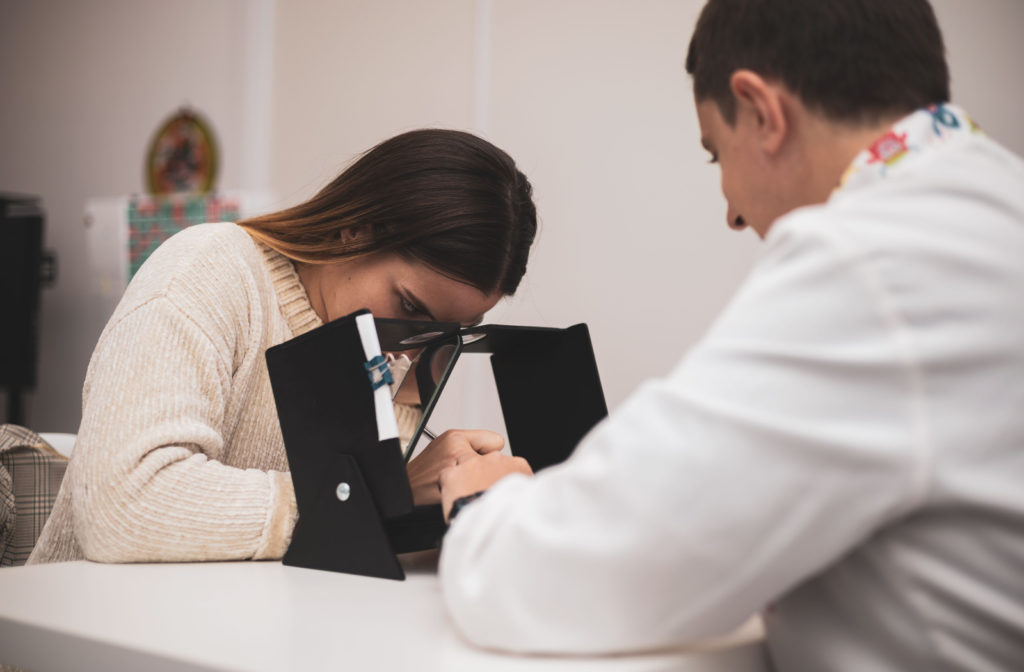Eye tracking is a wonderful ability—just one of the amazing things your eyes are capable of. It lets you track moving objects, jump between objects while focusing, and accurately interpret what you’re seeing. But sometimes, you may develop a problem with your vision, leading to everyday difficulties. When this happens, it’s time to see your optometrist—but in the meantime, how does an eye-tracking problem affect you?
Eye tracking lets you follow the words on a page smoothly and seamlessly without needing to stop and analyze each individual word. When you have a problem with your eye tracking, you’ll often lose your place, need to re-read sections often, or feel fatigued after reading. This can make reading much more difficult than it should be.
What Is Eye Tracking?
Eye tracking, sometimes called visual tracking, is a critical visual skill. It refers to how your eye can track a moving object seamlessly or switch between two objects. It’s supposed to be accurate, smooth, quick, and efficient.
There are several components of eye tracking:
- Saccades: Your ability to efficiently and quickly move your focus from one point to another.
- Fixations: Your ability to keep your focus on something.
- Pursuits: Your ability to follow a moving object accurately.
Eye tracking is the coordinated effort of both eyes using these three components, and it lets you efficiently scan and process visual information. It’s a crucial part of a well-functioning visual system.
Why Is Eye Tracking So Important?
Eye tracking is vital because it affects many aspects of our everyday life. When reading, you need to move from one word to the next seamlessly and subconsciously. This skill lets you focus on the sentence’s meaning without having to think about each word to process the information.
Eye tracking isn’t just about reading. You use eye tracking almost constantly throughout your day. It’s essential for tasks like:
- Driving safely: You need to be able to see signs, other cars, pedestrians, and more.
- Playing sports: You need to track moving objects.
- Walking straight: Walking through crowded spaces without bumping into others.
- Watching movies: You need to track moving objects on the screen.
- Using your cell phone: You need to be able to read the fine print and jump between apps, lines, and more.
You use eye tracking for any task that you’re using your eyes for. It’s a crucial skill, but it doesn’t always work perfectly. This makes it essential to learn how to tell if you’re having problems with your eye tracking so you can address the problem.
Signs That You Have a Problem with Your Eye Tracking
How can you tell if you’re having problems with your eye tracking? You’ll need to pay attention to your reading habits and visual patterns. If you notice any of the following, you may have a problem with your eye tracking.
- You often lose your place when reading or writing.
- You need to re-read sections to understand the words.
- You often reread lines.
- You write numbers or letters in reverse.
- You often squint or rub your eyes when focusing on something.
- You get headaches, eye strain, or fatigue when reading or writing.
- You need to use a finger to keep your place on a page.
If you notice any of these signs, it’s time to visit your optometrist to talk about potential solutions.
Can You Improve Your Eye Tracking Abilities?
There is good news, though; you can improve your eye tracking. Just like most other body parts, your eyes are controlled by specific muscles that help coordinate your movements. By training these muscles to function properly, you can improve your eye tracking and several other visual skills to build a new foundation for your visual system.
It all starts with a visit to your optometrist to discuss vision therapy!

What Is Vision Therapy?
When you break a leg, you often need to re-learn how to use the muscles properly through physiotherapy. Think of vision therapy like physiotherapy—you will work closely with an experienced vision therapist to re-train your visual system. It’s a non-invasive and surgery-free way to help improve your visual abilities.
In vision therapy, you work through a series of personalized exercises under the supervision of your eye care professional. It’s about more than just fixing your eye-tracking abilities. Instead, these exercises aim to improve several different parts of your visual system, including:
- Depth perception: Allowing you to judge how far away objects are.
- Focusing speed and accuracy: Enhancing your ability to change focus between objects at different distances quickly.
- Peripheral vision: Helping you to see and recognize objects outside the direct line of sight.
- Visual processing speed and accuracy: Improving the rate at which your brain interprets and reacts to visual information.
- Hand-eye coordination: Essential for activities that depend on fine motor skills.
These exercises can help improve eye movement control and coordination, leading to better control over your visual system.
Should I Try Vision Therapy?
If you’re having difficulty reading or performing other tasks requiring precise eye movements, talk to our team at Total Vision Rancho Bernardo for a consultation.
We can examine your eyes and test your visual abilities to determine if vision therapy is right for you. Your vision is precious, and taking care of it should always be a priority, so book an appointment with our team today.


